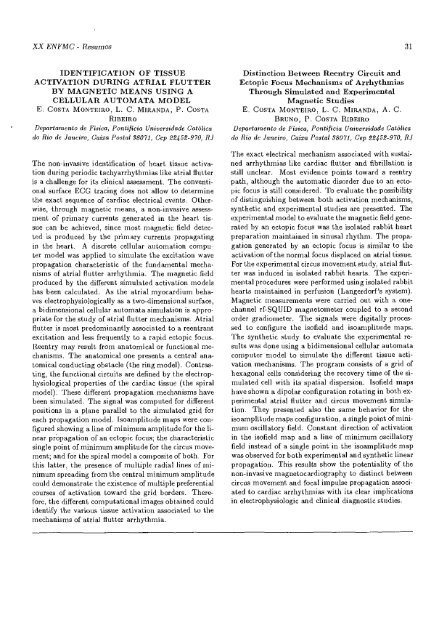'X' ENCON,TRO NACIONAL DE FISICA DA MATERIA CONDENSADA
'X' ENCON,TRO NACIONAL DE FISICA DA MATERIA CONDENSADA
'X' ENCON,TRO NACIONAL DE FISICA DA MATERIA CONDENSADA
You also want an ePaper? Increase the reach of your titles
YUMPU automatically turns print PDFs into web optimized ePapers that Google loves.
XX ENFMC - Resumos 31<br />
I<strong>DE</strong>NTIFICATION OF TISSUE<br />
ACTIVATION DURING ATRIAL FLUTTER<br />
BY MAGNETIC MEANS USING A<br />
CELLULAR AUTOMATA MO<strong>DE</strong>L<br />
E. COSTA MONTEIRO, L. C. MIRAN<strong>DA</strong>, P. COSTA<br />
RIBEIRO<br />
Departatnento de Fisica, Pontificia Universidade Catolica<br />
do Rio de Janeiro, Caisa Postal 38071, Cep 22452-970, RJ<br />
The non-invasive identification of heart tissue activation<br />
during periodic tachyarrhythmias like atrial flutter<br />
is a challenge for its clinical assessment. The conventional<br />
surface ECG tracing does not allow to determine<br />
the exact sequence of cardiac electrical events. Otherwise,<br />
through magnetic means, a non-invasive assessment<br />
of primary currents generated in the heart tissue<br />
can be achieved, since most magnetic field detected<br />
is produced by the primary currents propagating<br />
in the heart. A discrete cellular automation computer<br />
model was applied to simulate the excitation wave<br />
propagation characteristic of the fundamental mechanisms<br />
of atrial flutter arrhythmia. The magnetic field<br />
produced by the different simulated activation models<br />
has been calculated. As the atrial myocardium behaves<br />
electrophysiologically as a two-dimensional surface,<br />
a bidimensional cellular automata simulation is appropriate<br />
for the study of atrial flutter mechanisms. Atrial<br />
flutter is most predominantly associated to a reentrant<br />
excitation and less frequently to a rapid ectopic focus.<br />
Reentry may result from anatomical or functional mechanisms.<br />
The anatomical one presents a central anatomical<br />
conducting obstacle (the ring model). Contrasting,<br />
the functional circuits are defined by the electrophysiological<br />
properties of the cardiac tissue (the spiral<br />
model). These different propagation mechanisms have<br />
been simulated. The signal was computed for different<br />
positions in a plane parallel to the simulated grid for<br />
each propagation model. Isoamplitude maps were configured<br />
showing a line of minimum amplitude for the linear<br />
prOpagation of an ectopic focus; the characteristic<br />
single point of minimum amplitude for the circus movement;<br />
and for the spiral model a composite of both. For<br />
this latter, the presence of multiple radial lines of minimum<br />
spreading from the central minimum amplitude<br />
could demonstrate the existence of multiple preferential<br />
courses of activation toward the grid borders. Therefore,<br />
the different computational images obtained could<br />
identify the various tissue activation associated to the<br />
mechanisms of atrial flutter arrhythmia.<br />
Distinction Between Reentry Circuit and<br />
Ectopic Focus Mechanisms of Arrhythmias<br />
Through Simulated and Experimental<br />
Magnetic Studies<br />
E. COSTA MONTEIRO, L. C. MIRAN<strong>DA</strong>, A. C.<br />
BRUNO, P. COSTA RIBEIRO<br />
Departarnento de Fisica, Pontificia Universidade Catolica<br />
do Rio de Janeiro, Cairo Postal 38071, Cep 22.452-970, RJ<br />
The exact electrical mechanism associated with sustained<br />
arrhythmias like cardiac flutter and fibrillation is<br />
still unclear. Most evidence points toward a reentry<br />
path, although the automatic disorder due to an ectopic<br />
focus is still considered. To evaluate the possibility<br />
of distinguishing between both activation mechanisms,<br />
synthetic and experimental studies are presented. The<br />
experimental model to evaluate the magnetic field generated<br />
by an ectopic focus was the isolated rabbit heart<br />
preparation maintained in sinusal rhythm. The propagation<br />
generated by an ectopic focus is similar to the<br />
activation of the normal focus displaced on atrial tissue.<br />
For the experimental circus movement study, atrial flutter<br />
was induced in isolated rabbit hearts. The experimental<br />
procedures were performed using isolated rabbit<br />
hearts maintained in perfusion (Langerdorf's system).<br />
Magnetic measurements were carried out with a onechannel<br />
rf-SQUID magnetometer coupled to a second<br />
order gradiometer. The signals were digitally processed<br />
to configure the isofield and isoamplitude maps.<br />
The synthetic study to evaluate the experimental results<br />
was done using a bidimensional cellular automata<br />
computer model to simulate the different tissue activation<br />
mechanisms. The program consists of a grid of<br />
hexagonal cells considering the recovery time of the simulated<br />
cell with its spatial dispersion. Isofield maps<br />
have shown a dipolar configuration rotating in both experimental<br />
atrial flutter and circus movement simulation.<br />
They presented also the same behavior for the<br />
isoamplitude maps configuration, a single point of minimum<br />
oscillatory field. Constant direction of activation<br />
in the isofield map and a line of minimum oscillatory<br />
field instead of a single point in the isoamplitude map<br />
was observed for both experimental and synthetic linear<br />
propagation. This results show the potentiality of the<br />
non-invasive magnetocardiography to distinct between<br />
circus movement and focal impulse propagation associated<br />
to cardiac arrhythmias with its clear implications<br />
in electrophysiologic and clinical diagnostic studies.
















